Serviços Personalizados
Journal
Artigo
Indicadores
-
 Citado por SciELO
Citado por SciELO -
 Acessos
Acessos
Links relacionados
-
 Citado por Google
Citado por Google -
 Similares em
SciELO
Similares em
SciELO -
 Similares em Google
Similares em Google
Compartilhar
DYNA
versão impressa ISSN 0012-7353versão On-line ISSN 2346-2183
Dyna rev.fac.nac.minas v.79 n.172 Medellín mar./abr. 2012
ANALYSIS OF CONNECTED AIR VOIDS IN WARM MIX ASPHALT
ANÁLISIS DE VACÍOS CONECTADOS EN MEZCLAS ASFÁLTICAS TIBIAS
ALLEX E. ALVAREZ
Ph.D. Associate Professor, University of Magdalena, Santa Marta, Colombia, allexalvarez@yahoo.com
NELKIN MACIAS
University of Magdalena, Santa Marta, Colombia, macgnel@gmail.com
LUIS G. FUENTES
Ph.D. Assistant Professor, Universidad del Norte, Barranquilla, Colombia, lfuentes@uninorte.edu.co
Received for review July 22th, 2011, accepted November 23th, 2011, final version December, 9th, 2011
ABSTRACT: Warm mix asphalt mixtures (WMA) are asphalt mixtures produced at reduced temperatures, as compared to conventional hot mix asphalt (HMA). Temperature reductions in the order of 10 to 50°C are possible through the incorporation of diverse WMA-type additives. However, different aspects, including the mixture internal structure of WMA, are still an object of research. Consequently, this paper focuses on the assessment of the internal structure of WMA (computed in terms of the connected air voids (CAV) characteristics), fabricated using three WMA additives: Asphamin®, Sasobit®, and Evotherm®. The CAV content corresponds to the fraction of air voids (AV) forming connected paths in a compacted specimen and is better related to the asphalt mixture response (e.g., permeability) than the total AV content. The CAV analysis was based on X-ray computed tomography scanning and subsequent image analysis. Corresponding results suggest the need for additional research to further characterize field compacted mixtures, produced at densification levels comparable to those achieved in the laboratory. In addition, the inclusion of WMA additives and corresponding temperature reductions did not substantially affect the internal structure of gyratory-compacted specimens (115 mm in height) produced for laboratory mixture evaluation.
KEYWORDS: warm mix asphalt (WMA), connected air voids (CAV), X-ray computed tomography (X-ray CT), internal structure, hot mix asphalt (HMA).
RESUMEN: Las mezclas asfálticas tibias (MAT) son mezclas asfálticas producidas a temperaturas reducidas en comparación con las mezclas asfálticas en caliente (MAC) convencionales. Reducciones de temperatura del orden de 10 a 50°C son posibles mediante la incorporación de diversos aditivos tipo MAT. Sin embargo, diferentes aspectos, incluyendo la estructura interna de MAT, aún son objeto de estudio. Consecuentemente, este artículo se centró en la evaluación de la estructura interna de MAT (calculada en términos de las características de los vacíos conectados (VC)), fabricadas con tres aditivos tipo MAT: Asphamin®, Sasobit®, y Evotherm®. El contenido de VC corresponde a la fracción de vacíos que forman rutas conectadas en un espécimen compactado y está mejor relacionado con la respuesta de la mezcla asfáltica (e.g., permeabilidad) que el contenido total de vacíos. El análisis de VC se basó en la aplicación de tomografía computarizada con rayos-X y el subsecuente análisis de imágenes. Los resultados correspondientes sugirieron la necesidad de realizar investigación adicional para caracterizar mezclas compactadas en campo, producidas a niveles de densificación comparables con aquellos obtenidos en laboratorio. Adicionalmente, la inclusión de aditivos tipo MAT y la correspondiente reducción de temperatura no afectaron notoriamente la estructura interna de especímenes compactados en laboratorio (115 mm de altura) producidos para evaluación de mezcla en laboratorio.
PALABRAS CLAVE: mezcla asfáltica tibia, vacíos conectados, tomografía computarizada con rayos-X, estructura interna, mezcla asfáltica en caliente.
1. INTRODUCTION
During the last two decades, a new set of technologies-termed warm mix asphalt (WMA)-engineered to reduce the temperatures required for production and construction of hot mix asphalt (HMA) were introduced in the road construction industry. At present, these technologies allow for WMA fabrication with temperature reductions of 10 to 50°C, as compared to the conventional HMA [1], depending on the principle of the technology applied. The existent WMA technologies can be grouped as: moisture-based agents (foaming), emulsion-based, wax-based, and surfactants.
The temperature reductions obtained for fabrication of WMA have beneficial effects on the environment, since they are related to less fuel use and reduced emissions for construction of asphalt mixtures. Economical benefits (extended paving seasons and less plant wear) and engineering benefits (less potential for oxidative aging of asphalt) are also derived from using WMA as an alternative to HMA [1-6]. These benefits have motivated the rapid growth of developments in WMA technologies around the world, especially during the last decade [1,5], accompanied by an important amount of research to evaluate WMA produced as part of field projects as well as in the laboratory [1,7,8]. Most of this research focused on macroscopically assessing the response and performance of WMA as compared to that of reference HMA mixtures.
Therefore, an important aspect to advance in the characterization of WMA corresponds to the analysis of its internal structure (the arrangement of the constituents of the mixture). The internal structure can be computed in terms of the air voids (AV) characteristics-distribution, size, and connectivity-and the aggregate particles structure-distribution, orientation, and contact-[9,10]. In this manner, the internal structure was successfully analyzed in previous research, for both dense-graded HMA [11-14] and open-graded HMA [15], based on X-ray computed tomography (X-ray CT) scanning and subsequent image analysis techniques.
The analysis of the internal structure of WMA can permit additional comparisons with control-HMA mixtures to establish possible differences -at a smaller scale-due to the reduction of the fabrication temperature through the addition of WMA additives. Recently, Alvarez et al. [16] analyzed the internal structure (in terms of the AV characteristics; i.e., distribution and size of the AV forming the total AV content) of WMA specimens compacted in the laboratory. However, additional research is still required to further analyze the internal structure of both laboratory- and field-compacted WMA as well as the connected air voids (CAV) in the WMA.
Consequently, this paper studies the internal structure of laboratory- and field (road cores)-WMA compacted specimens, in terms of the content of CAV as well as the vertical distribution of both the content and size of CAV. The CAV content was defined as the fraction of AV forming connected paths from top to bottom in a compacted specimen and was calculated based on analysis of computer images scanned by using the X-ray CT. This computation of CAV is considered a valid determination of the effective AV (proportion of AV connected in the bulk volume of an HMA) [15], defined in previous research [17,18]. As concluded in previous research, the evaluation of CAV is valuable, since the CAV content values can correlate better (than the total AV content values) with the HMA response. Support of this improved correlation was discussed in previous research conducted on permeable friction course mixtures [19] and dense-graded HMA [20,21].
In this context, the objective of the paper is to determine whether the internal structure of WMA, computed in terms of the CAV characteristics, is similar to that of the conventional control-HMA mixtures (used as reference). The initial hypothesis is that the fabrication of WMA at reduced temperature (compared to that of HMA) does not generate substantial differences in the internal structure (CAV) of the asphalt mixture. The additives used to fabricate the WMA analyzed were Asphamin®, Sasobit®, and Evotherm®.
The paper first presents the methods and materials, followed by a section on the computation of CAV based on X-ray CT and image analysis techniques. The results and discussion are then presented as well as conclusions and recommendations to complete the paper.
2. METHODS AND MATERIALS
Characterization of the CAV was conducted on both WMA and control-HMA, whose composition (Table 1) only differed in the addition of WMA additives to reduce the fabrication temperature for the WMA. Therefore, the control-HMA served as a reference to comparatively evaluate the combined effect of including WMA additives and reducing the fabrication temperature. As indicated in the Table 1, the WMA asphalt content corresponded to the optimum asphalt content determined for the control-HMA.
Table 1. Characteristics of the mixtures evaluated
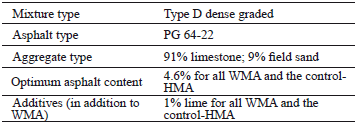
Three WMA additives were used in this study, namely: Sasobit®, Asphamin®, and Evotherm®.
As an asphalt modifier, the Sasobit® is engineered to reduce asphalt viscosity [1]. Asphamin® is a hydro-thermally crystallized synthetic zeolite, and at temperatures above 100°C, it releases water and foams the asphalt. Based on this principle, Asphamin® enhances the aggregate coating and increases the workability at reduced temperatures [1]. Evotherm® is an emulsion-type product designed to offer a high asphalt residue. This product also includes adhesion promoters and additives to enhance the aggregate coating [22]. The WMA additives were added as recommended by the manufacturers based on the following proportions: Sasobit® at 3% by weight of the asphalt, Advera® at 0.5% by weight of the mix, and Evotherm® at 0.5% by weight of the asphalt. Detailed discussions on the characteristics of these WMA additives are reported elsewhere [1,4].
The mixture design was conducted in accordance with the Texas Department of Transportation (TxDOT) mix design procedure for dense-graded HMA [23] and corresponding specifications of materials [24]. The mixtures evaluated for CAV-mixture internal structure-included both laboratory compacted specimens and corresponding road cores (152.4 mm in diameter) extracted from an actual field project constructed using both the control-HMA and WMA. In the field, the temperatures at load out for the control-HMA and WMA were 132°C and 115.5°C, respectively.
Laboratory compacted specimens were produced in accordance with the test method Tex-241-F [23] using a Servopac Superpave Gyratory Compactor (SGC). In this study, the SGC produced 152.4 mm diameter specimens at two heights (115±5 and 62±2 mm; Table 2). The results in Table 2 are based on the analysis of one specimen of each mixture type.
Table 2. Compaction temperature and air voids (AV) content of scanned specimens
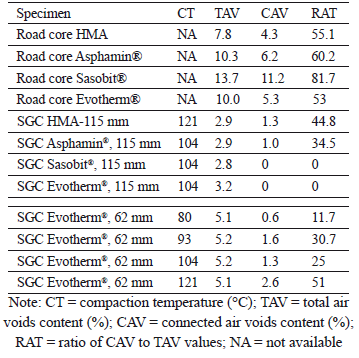
The first specimens set (115 mm in height), allowed for comparison of the mixture internal structure of specimens typically used for mixture performance evaluation. The second set (62 mm in height specimens), was used to analyze the effect of compaction temperature on the CAV characteristics of short WMA specimens used for mixture performance evaluation in the Hamburg wheel tracking test [25]. The 62 mm in height specimens were compacted at 121°C (specified compaction temperature for the control-HMA), 104°C, 93 °C, and 80°C (cessation temperature for field compaction of the control-HMA). The intermediate temperatures are potential temperatures for WMA field compaction.
After extraction or production, both the road cores and SGC specimens were tested for calculation of the total AV content (Table 2) [23], and scanned using the X-ray CT equipment. Details on the analysis of CAV based on image analysis are subsequently presented. However, to facilitate the comparison of AV values, the CAV content values are also included in Table 2.
3. ANALYSIS OF CONNECTED AIR VOIDS (CAV)
In this study, the content and the vertical distribution (i.e., determined along the specimen height) of the CAV were computed by applying image analysis procedures. These procedures were carried out on computer images (transversal horizontal bidimensional sections reconstructed as grayscale images) obtained by using the X-ray CT equipment at Texas A&M University. Thus, a set of "n" parallel grayscale images, obtained with a 1 mm vertical gap represented a specific cylindrical HMA or WMA specimen. Details on the principle of operation of the X-ray CT scanning system are presented elsewhere [26,27].
Figure 1(a) exemplifies a grayscale image obtained at a particular height of a dense-graded WMA specimen. The resolution of these images was approximately 0.17 mm/pixel. Based on this type of images, a three steps image analysis was conducted to compute the CAV characteristics. These stages corresponded to: (i) thresholding, (ii) analysis of AV connectivity, and (iii) computation of the CAV characteristics (content and size per image).
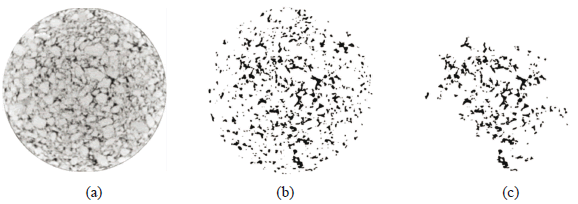
Figure 1. Grayscale image (a), and corresponding black and white images of total air voids (b), and connected air voids (CAV) (c), for a dense-graded WMA specimen
Thresholding the grayscale images generated black and white images (Fig. 1(b)), where the pixels representing AV became black and the pixels related to both the aggregate and mastic became white. This process was conducted using the Image-Pro® Plus software [28]. The particular threshold value (determined for each specimen analyzed based on successive approximations) applied in order to obtain the black and white images ensured that the mean total AV content value calculated for the set of n images representing a specific specimen equals the total AV content measured in the laboratory for that specimen. Thus, these images are considered "black and white images of total AV content" (Fig. 1(b)).
In the second stage, the analysis of AV connectivity was conducted by converting the black and white images of total AV content in binary .bit files through the application of a macro developed [29] by using Image-Pro® Plus. A Fortran-built algorithm [29] was then used to analyze the set of binary files representing a specimen and establish connected paths-connected pixels-from the top to the bottom of the specimen. As documented in detail by Masad et al. [29], new binary .bit files containing the connected AV result from the analysis. Using Image-Pro® Plus, the binary .bit files are subsequently converted back to .tif images. These images are considered "black and white images of CAV" (e.g., Fig. 1(c)).
In the third stage (computation of the CAV characteristics), the CAV content and CAV size per image were computed based on the black and white images of CAV representing a particular specimen. Based on these values-computed for images spaced 1 mm apart-, the vertical distribution of both CAV content and CAV size was also determined. Computation of the CAV characteristics was conducted by applying a macro that was developed [29] based on Image-Pro® Plus.
For the black and white image of CAV, the CAV content (CAVi) was computed as follows, as a function of the area of AV in image i (CAvi) and cross-sectional area (circle area) of image i (AT ) (Fig. 1(c)):

The CAV content of a particular specimen (CAVs), which is represented by n images, was calculated as:

The CAV size in image i was computed in terms of the mean radius of CAV (C ). The corresponding calculation was based on Eq. 3, where Mi corresponds to the number of CAV calculated in image i.
). The corresponding calculation was based on Eq. 3, where Mi corresponds to the number of CAV calculated in image i.

4. RESULTS AND DISCUSSION
This section presents the results of CAV characteristics evaluated for: (i) field compacted mixtures, (ii) laboratory (SGC) compacted mixtures, and (iii) SGC specimens of Evotherm® WMA compacted at different temperatures.
4.1. Analysis of connected air voids (CAV) in field-compacted mixtures (road cores)
Figures 2 and 3 show, respectively, the vertical distributions of CAV content and CAV size for road cores extracted from both the control-HMA and WMA field sections. Although the same total AV content value was targeted for the field compaction of all mixtures, the total AV content-densification level-of the road cores differed for each mixture as summarized in Table 2. The maximum position value (i.e., specimen thickness) in Figures 2 and 3 differed for each mixture due to divergences in the field compacted thickness.
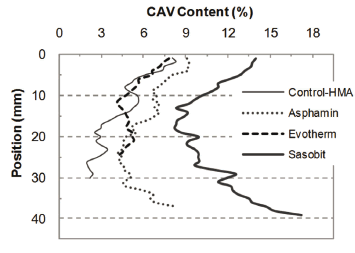
Figure 2. Vertical distribution of CAV content for road cores (control-HMA and WMA)
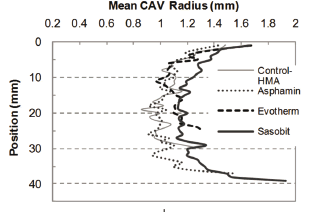
Figure 3. Vertical distribution of CAV size for road cores (control-HMA and WMA)
Therefore, the vertical distributions of CAV characteristics for road cores are not directly comparable, since, as suggested in previous research [15], these distributions can change as the densification level increases to make the total AV content-field control parameter-comparable for all the mixtures. Based on the same reasoning, the ratio of CAV content to total AV content values for road cores presented in Table 2, are not directly comparable.
Based on the field compaction control, the maximum difference in the total AV content value for the four mixtures studied was 1.6 percentage points (based on a reduction temperature from 132 °C for the control-HMA to 115.5°C for the WMA mixtures). Therefore, at the macroscopic level, it can be preliminarily concluded that this temperature reduction did not lead to substantial modifications in the densification of WMA mixtures as compared to the control-HMA. At the microscopic level, however, additional research is still required to study the internal structure of WMA mixtures and the corresponding control-HMA compacted at comparable total AV content values. Replicate specimens should also be analyzed to evaluate the variability of the mixture internal structure.
4.2. Analysis of connected air voids (CAV) in laboratory-compacted mixtures
The data shown in Fig. 4 indicate comparable vertical distributions of CAV content for both the control-HMA and WMA specimens fabricated using the SGC. In general, for these specimens the differences in CAV content are smaller than one percentage point, which is a small value compared to the conventional variability of total AV content values in HMA production.
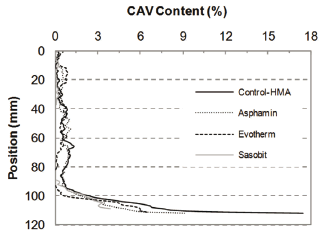
Figure 4. Vertical distribution of CAV content for SGC laboratory compacted specimens
In addition, the vertical distributions of CAV size, shown in Fig. 5, are comparable despite the variability of this index along the specimen height. However, the Sasobit®-WMA specimen only showed partial connectivity in the top and bottom portions (with no connectivity in the central portion; i.e., in the range of 37 to 89 mm). In a smaller proportion, the connectivity of the Evotherm®-WMA specimen was also cancelled, with no connectivity in a small section at the bottom of the specimen (Figs. 4 and 5).
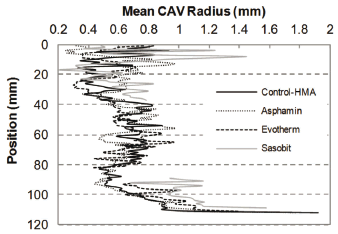
Figure 5. Vertical distribution of CAV size for SGC laboratory compacted specimens
Since the total AV content values for all the 115 mm in height SGC specimens are comparable, this particular response suggests improved compactability for both the Sasobit®- and Evotherm®-WMA as compared to the control-HMA. The improved compactability led to a closer arrangement of aggregates, and consequently, to a reduction of both the CAV content and the ratio of CAV content to total AV content values for the corresponding SGC specimens (Table 2). In terms of decreased permeability, for example, the reduction of the CAV content can be thought of as an advantage of the Sasobit®-WMA and Evotherm®-WMA over the control-HMA. However, additional research is required to better understand if this potential advantage is actually translated to the field.
Overall, the inclusion of the three WMA additives, and corresponding reduction of the mixture fabrication temperature (from 121 to 104°C; Table 2), generated positive results in the SGC compacted specimens. In addition, a formal comparison of the CAV of laboratory- and field-compacted mixtures was not pursued, given their differences in degree of densification (i.e., total AV content values reported in the Table 2).
4.3. Effect of compaction temperature on the characteristics of CAV
This section summarizes the results of the CAV characteristics evaluated for Evotherm®-WMA specimens (62 mm in height) compacted at different temperatures in the laboratory. These 62 mm-in-height specimens are specifically used to assess the resistance to permanent deformation using the Hamburg wheel tracking test (Tex-242-F [25]). For these short specimens, Figs. 6 and 7, respectively, show the vertical distribution of CAV content and CAV size.
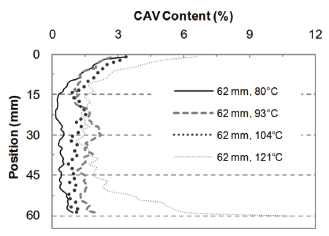
Figure 6. Vertical distribution of CAV content for short SGC specimens compacted at different temperatures
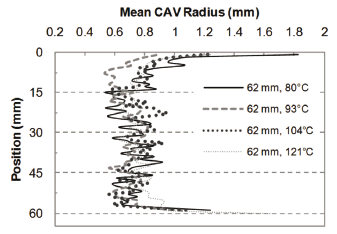
Figure 7. Vertical distribution of CAV size for short SGC specimens compacted at different temperatures
The temperature modification-from the compaction temperature specified for the control-HMA (121 °C) to its cessation temperature (80 °C)-had a minimum effect on the distribution of CAV size computed for the SGC specimens fabricated using the Evotherm®-WMA additive (Fig. 7). However, in terms of the CAV content distribution, this temperature reduction led to a more uniform vertical distribution of CAV (Fig. 6). This modification is considered a positive effect of the Evotherm®-WMA technology, since a uniform distribution of AV in laboratory-compacted specimens is convenient to conduct actual measurements of material properties and response. Overall, these results support the feasibility of reducing the compaction temperature in the laboratory through the use of the Evotherm®-WMA additive.
Figure 8 shows a comparison of the vertical distribution of CAV content for both 62 mm and 115 mm in height SGC specimens, fabricated using the Evotherm®-WMA additive. The taller specimens are used for laboratory mixture performance evaluation and to produce short specimens (e.g., by cutting to 62 mm-in-height specimens) for laboratory testing [23]. As shown in Fig. 8, the short SGC specimens tend to present more irregular vertical distributions of CAV content, as compared to that of 115 mm-in-height specimens, namely at the top portion (i.e., 1 to 20 mm).
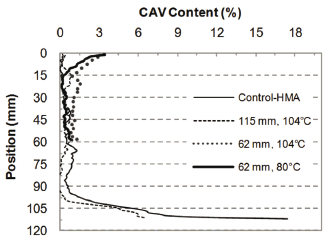
Figure 8. Comparison of the vertical distribution of CAV content for 62 mm and 115 mm in height SGC specimens (Evotherm®-WMA and control-HMA)
Additional analysis of the vertical distribution of total AV content for these SGC specimens (not shown in Fig. 8) showed an irregular "C" shape distribution of AV-minimum total AV content values at the central portion and high values at the top- and bottom-portions of the specimen-. Based on these two complementary analyses, it is recommended that the SGC specimens used for the Hamburg wheel tracking test should be cut from 115 mm-in-height specimens. Cutting the top and bottom portions, to get a 62 mm-in-height specimen [23], of these tall SGC specimens can produce more homogeneous distributions of AV for subsequent performance evaluation.
5. CONCLUSIONS AND RECOMMENDATIONS
This paper presents an evaluation of CAV (i.e., content, size, and distribution) of WMA mixtures fabricated using three WMA additives-Asphamin®, Sasobit®, and Evotherm®-compacted in both the laboratory and field. The parameters evaluated are indicative of the internal structure of these WMA and were determined using nondestructive X-ray CT scanning and subsequent image analysis techniques. Based on the results obtained and the analysis conducted, the following conclusions are offered:
- At the macroscopic level, preliminary evidence suggests that the temperature reduction for field compaction of WMA did not induce substantial modifications in the densification of WMA mixtures as compared to the control-HMA. However, at the microscopic level-based on the conducted analysis of mixture internal structure-additional research is still required to better characterize both the WMA mixtures and corresponding control-HMA compacted at similar densification levels.
- This analysis can provide information on possible differences-as compared to the HMA characteristics-generated by the inclusion of WMA additives and the consequent reduction in temperature for the WMA mixture fabrication. This future research could also contribute to improve the comparison of laboratory- and field-compacted mixtures to better validate laboratory evaluations, comparisons, and determinations.
- The comparison of the vertical distribution of CAV content and CAV size for 115 mm-in-height SGC specimens suggested that the inclusion of WMA additives and corresponding temperature reduction did not substantially affect the internal structure of this type of specimen. In addition, the Sasobit®-WMA and Evotherm®-WMA specimens showed no connectivity in the central portion of the specimen. This lack of connectivity (opposite of the full connectivity shown by the control-HMA) suggested improved compactability for both WMA mixtures as compared to the control-HMA. However, additional research is required to better understand if this potential advantage is actually translated to the field.
- The preliminary evaluation of 62 mm-in-height SGC specimens (fabricated using the Evotherm®-WMA additive) used for performance evaluation, led to recommend the fabrication of this type of specimen based on the compaction of 115 mm-in-height specimens. Specifically, cutting the top and bottom sections of the tall specimens to get the 62 mm specified height was suggested to improve the homogeneity of the AV distribution. Additional evaluation of the internal structure of short specimens, using other WMA additives is required to fully validate the recommendations indicated.
6. DISCLAIMER
This paper does not constitute a standard, specification, nor is it intended for design, construction, bidding, contracting, or permit purposes. Trade names were used solely for information and not for product endorsement.
7. ACKNOWLEDGEMENTS
The authors express their thanks to Dr. Amy Epps Martin (Texas A&M University) and P.E. Cindy Estakhri (Texas Transportation Institute, The Texas A&M University System) for the support provided to successfully complete the study. Thanks also go to Eng. David Zeig (Texas Transportation Institute, The Texas A&M University System), for his valuable assistance and cooperation. The first author, as Associate Professor at the University of Magdalena, expresses special thanks to this institution for the full support received to complete this work.
REFERENCES
[1] Button, J. W., Wimsatt, A. and Estakhri, C., A synthesis of warm-mix asphalt. FHWA/TX-07/0-5597-1. Texas Transportation Institute-Texas A&M University, College Station, TX, 2007. [ Links ]
[2] Estakhri, C., B, J. and Alvarez, A. E., Field and laboratory investigation of warm mix asphalt in texas. Report No FHWA/TX-10/0-5597-2. Texas Transportation Institute-Texas A&M University, College Station, TX, 2010. [ Links ]
[3] You, Z. and Goh, S. W., Laboratory evaluation of warm mix asphalt: A preliminary study, International Journal of Pavement Research and Technology, 1 (1), pp. 34-40, 2008. [ Links ]
[4] Silva, H. M. R. D., Oliveira, J. R. M., Ferreira, C. I. G. and Pereira, P. A. A., Assessment of the performance of warm mix asphalts in road pavements, International Journal of Pavement Research and Technology, 3 (3), pp. 119-127, 2010. [ Links ]
[5] Haggag, M. M., Mogawer, W. S. and Bonaquist, R., Fatigue evaluation of warm mix asphalt mixtures using uniaxial cyclic direct tension compression test, TRB 90th Annual Meeting, pp. 1-12, 2011. [ Links ]
[6] Kristjánsdóttir, Ó., Muench, S. T., Michael, L. and Burke, G., Assessing potential for warm-mix asphalt technology adoption, Transportation Research Record, 2040, pp. 91-99, 2007. [ Links ]
[7] Hurley, G. C. and Prowell, B. D., Evaluation of evotherm® for use in warm mix asphalt. NCAT Report 06-02. National Center for Asphalt Technology-Auburn University, Auburn, AL, 2006. [ Links ]
[8] Yan, J., Cao, Y., Zhu, T., Cai, M., Cao, Z., Huang, W. and Dong, Q., Shanghai experience with warm mix asphalt, Geotechnical Special Publication No. 203, pp. 97-102, 2010. [ Links ]
[9] Alvarez, A. E., Epps Martin, A. and Estakhri, C., Connected air voids content in permeable friction course mixtures, Journal of Testing and Evaluation, 37 (3), pp. 254-263, 2009. [ Links ]
[10] Alvarez, A. E., Epps Martin, A. and Estakhri, C., Effects of densification on permeable friction course mixtures, Journal of Testing and Evaluation, 37 (1), pp. 11-20, 2009. [ Links ]
[11] Masad, E., Jandhyala, V. K., Dasgupta, N., Somadevan, N. and Shashidhar, N., Characterization of air void distribution in asphalt mixes using X-Ray computed tomography, Journal of Materials in Civil Engineering, 14 (2), pp. 122-129, 2002. [ Links ]
[12] Masad, E., Kassem, E. and Chowdhury, A., Application of imaging technology to improve the laboratory and field compaction of HMA. Report No FHWA/TX-09/0-5261-1. Texas Transportation Institute-Texas A&M University, College Station, TX, 2009. [ Links ]
[13] Thyagarajan, S., Tashman, L., Masad, E. and Bayomy, F., The heterogeneity and mechanical response of hot mix asphalt laboratory specimens, International Journal of Pavement Engineering, 11 (2), 107-121, 2010. [ Links ]
[14] Tashman, L., Masad, E., DAngelo, J., Bukowski, J. and Harman, T., X-ray tomography to characterize air void distribution in superpave gyratory compacted specimens, The International Journal of Pavement Engineering, 3 (1), pp. 19-28, 2002. [ Links ]
[15] Alvarez, A. E., Epps Martin, A. and Estakhri, C., Internal structure of compacted permeable friction course mixtures, Construction and Building Materials, 24 (6), pp. 1027-1035, 2010. [ Links ]
[16] Alvarez, A. E., Carvajal, J. S. and Reyes, O. J., Internal structure of laboratory compacted warm mix asphalt, DYNA, 172, 38-45, 2012. [ Links ]
[17] Chen, J., Lin, K. and Young, S., Effects of crack width and permeability on moisture-induced damage of pavements, Journal of Materials in Civil Engineering, 16 (3), pp. 276-282, 2004. [ Links ]
[18] Alvarez, A. E., Arambula, E. and Caro, S., Tomografía computarizada con Rayos-X y sistema de imágenes de agregados (AIMS) para el estudio de mezclas asfálticas y agregados, Ingeniería e Investigación, 28 (2), pp. 142-151, 2008. [ Links ]
[19] Alvarez, A. E., Epps, M. A. and Estakhri, C., Drainability of permeable friction course mixtures, Journal of Materials in Civil Engineering, ASCE, 22 (6), pp. 556-564, 2010. [ Links ]
[20] Mohammad, L. N., Herath, A. and Huang, B., Evaluation of permeability of superpave asphalt mixtures, TRB 2003 Annual Meeting, 2003. [ Links ]
[21] Masad, E. and Button, J., Implications of experimental measurements and analyses of the internal structure of hot-mix asphalt, Transportation Research Record, 1891, pp. 212-220, 2004. [ Links ]
[22] Estakhri, C., Cao, R., Alvarez, A. E. and Button, J. W., Production, placement, and performance evaluation of warm mix asphalt in texas, ASCE Geotechnical Special Publication: Material, Design, Construction, Maintenance, and Testing of Pavement, No 193, pp. 1-8, 2009. [ Links ]
[23] TXDOT. 200-f, bituminous test procedures manual. Available: http://www.txdot.gov/business/contractors_consultants/test_procedures/tms_series.htm?series=200-F [Cited: Accessed on February 2011]. [ Links ]
[24] TXDOT., Standard specifications for construction and maintenance of highways, streets, and bridges, Austin, TX, 2004. [ Links ]
[25] Zhou, F., Hu, S. and Scullion, T., Integrated asphalt (overlay) mixture design, balancing rutting and cracking requirements. Report No. FHWA/TX-06/0-5123-1. Texas Transportation Institute-Texas A&M University, College Station, TX, 2006. [ Links ]
[26] Masad, E., X-Ray computed tomography of aggregates and asphalt mixes, Materials Evaluation Journal, 62 (7), pp. 775-783, 2004. [ Links ]
[27] Shashidhar, N., X-Ray tomography of asphalt concrete, Transportation Research Record: Journal of the Transportation Research Board, (1681), pp. 186-192, 1999. [ Links ]
[28] MEDIA CYBERNETICS, L. P., Image-pro® plus, version 5.1.2. Georgia, M.D., 1999. [ Links ]
[29] Masad, E., Arambula, E., Ketcham, R. A., Abbas, A. R. and Martin, A. E., Nondestructive measurements of moisture transport in asphalt mixtures, Journal of the Association of Asphalt Paving Technologists (AAPT), 76, pp. 919-952, 2007. [ Links ]














